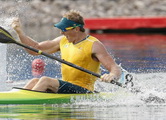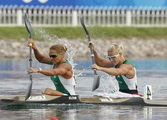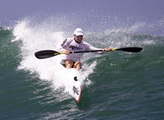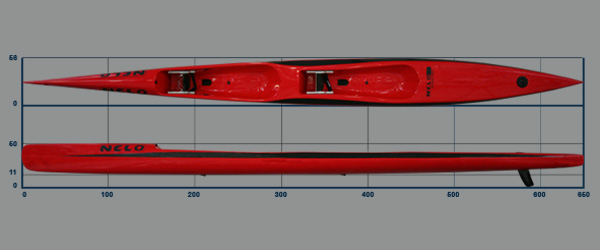News
What Erg for the winter???
|
Standard Erg and Slider compared.
For many years in the UK the Lawler erg was the industry standard and gave the chance to get “paddling fit” when access to the water was either too difficult or just too cold. The default winter fitness training tool for the elite down to grass roots paddlers, it seemed to fill the gap in the winter months. Recently machines with the same basic set up but with more sophisticated monitoring software have been on the market allowing users to measure their speed and power, paddle to certain pace requirements and indeed race each other online. What else could you need? Well over those years it was apparent to the designer of the original that the erg did not actually improve anyone’s actual ability in a kayak beyond simply improving their fitness. Something was missing from it and so the Lawler slider was born. This article hopefully will go some way to explaining the differences in use and function of each machine.
The original erg certainly reproduces the closest visual likeness to paddling in a kayak. The user feels the action is close enough to provide a likely crossover into their ability on the water. It is a perfect machine for a cardiovascular workout and pulse rate will reach as high (or higher) on the erg as it does in the boat. For those people who hate running the erg provides a very viable alternative.
When looking for what the erg lacks though the obvious thing is the instability of the kayak, it will not work the stabilizer muscles in nearly the same way as a real boat. Some manufacturers have seen this omission and produced ergs with seats attached to a rocker mechanism in the hope that this will move the action closer to the real thing. This however omits the other major factor that an erg cannot reproduce but is one of the most vital aspects of kayaking. Water offers an upward force against the downward force of your paddle (or should do if you are doing it right!) The erg cannot do this, in a boat therefore stability is gained by keeping weight on the paddle, this is good technique. On an erg with a wobbly seat you will not have this support so in order to keep balance the weight shift will not be in the direction it would be in the kayak and so becomes counter productive.
But the most significant difference between the erg and the real thing is that in a kayak the paddle is planted in the water and the body moves toward the paddle. In exercise terminology this is called a closed chain exercise, much like a chin up. On the erg the paddle will be pulled back to the body, an open chain exercise, much like a lat pull down. Though visually these exercises look very similar the recruitment pattern of the muscles are actually opposites. For evidence of this just go to the other exercises mentioned, the pull up and the lat pull down….how many people who cannot pull up are very happy to do a lat pull down and can even pull down more than their body weight? Despite this they still remain incapable of pulling up!! The erg has that exact same problem with transferability. So in short however “good” you get on the erg this will have no direct translation to how fast you are on the water. In fact I would guess that in most clubs the guy who is the best on the erg is probably quite far down the rankings on the water.
So is an erg completely pointless then? Absolutely not…. we have already said it is a perfect tool for keeping/getting fit on. Plug in your headphones and crunch out a session and you will be better off for it. It is also a great tool for coaches to explain technique and to help athletes visualize (not feel) good technique, Every club should have one for showing beginners the basic movement of body parts during the paddle stroke. In short the erg is a great supplement to work in the boat and should be used as such. It is not a substitute for work in the boat, so anyone who uses one in the hope that when they get back on the water in Spring they will be going much faster, will be disappointed.
The big danger with ergs is that people who are not so well coordinated on the water actually do much better relatively on the ergs and so enjoy using them more. They are more competitive with their club mates and enjoy that feeling. Ultimately though the erg will do nothing for your technique or your coordination with real water. For the very well coordinated, the ergs just provide a welcome distraction when it is cold outside, within a couple of paddle sessions the coordination will return and it will be business as usual.
Do I own and use a standard erg? Yes I do and will always use it when I feel the need to build a level of fitness that my limited time on the water will not give me. I also use it to hide from how slow I have got in my boat!
So where does the Lawler Slider fit in then?
The slider came about from discussions we have had over the years about what is lacking from the erg. It is a closed chain exercise and so already replicates the paddle stroke much more accurately. The nature of the setup also allows your downward force on the blade to be resisted and so learning to shift body weight onto the paddle is now a possibility. The addition of a wobbly seat could even be a bonus here.
On the slider the paddler performs one stroke at a time on the same side and so visually it is not as close to real paddling (unless you are a C1 paddler). It is very easy for a coach to see how the various body parts coordinate and fault finding is much easier than in a boat or on an erg. The speed of repetitions on the slider lend it more to a strength workout than a cardiovascular workout but continuous reps on a lower loading can get heart rates up pretty high. Loading can be increased to allow only one rep if that is your target and of course can be adjusted to suit whatever type of session your coach wants from you. What the slider does brilliantly is allow you to feel the connection between the driving foot on the pulling side and the top shoulder on the opposite side. It is this connection that separates the good paddlers from the average paddlers.
It also very clearly highlights where people who do not optimize their technique “spill” energy. Watching the top hand move before the sledge begins to move is a sure sign of a paddler who punches forward to escape the loading on the paddle. Leaning away from the pulling side shows someone who has not learnt to hold onto the force by getting their weight onto the paddle and so on. It is both a strength workout for the athlete and a very clear technique tool for the coach. If someone is good on the slider then it is a very good predictor of being good in the boat (assuming they have the ability to stay upright!)
In summary then, both tools have their place.
The standard erg is a perfect fitness tool for the cardiovascular system. It is a very welcome relief from the cold days, and is a useful technique and teaching tool. Being good on the erg has no bearing on how good you will be in your boat but you will be better physically prepared for your spring sessions.
The slider is more of a strength-training tool but its additional beauty is that improvement on the slider will translate to improvement on the water. It is the best technique teaching tool there is and will highlight weak points perfectly. It can be used to improve cardiovascular capacity but to be fair it would be quite boring!
Either tool used well will help your paddling in the long run but neither substitute for time on the water. If you pinned me down to which one I would have if I were limited to one, it would be a vague answer and would depend on what my aim was.
If I want to keep fit during the winter months I would go for the standard erg. However if I wanted to improve my canoeing ability and go faster then it would have to be the slider. |




